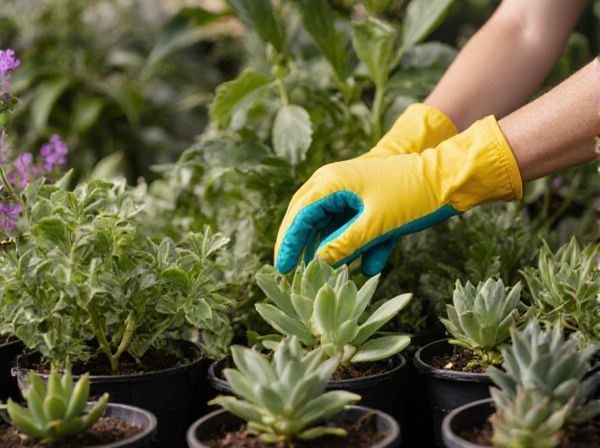
Nurse plants vs host plants Illustration
Nurse plants create a protective microenvironment that facilitates the establishment and growth of other plants by improving soil moisture and providing shade. Host plants, in contrast, directly support parasitic or symbiotic species by offering nutrients or structural support. Understanding the distinct roles of nurse and host plants helps optimize plant community dynamics and ecosystem restoration efforts.
Table of Comparison
| Aspect | Nurse Plants | Host Plants |
|---|---|---|
| Definition | Plants that facilitate the growth of seedlings by providing shade, moisture, and protection. | Plants that provide physical support or habitat to other organisms, such as epiphytes or parasites. |
| Function | Enhance seedling survival and establishment in harsh environments. | Serve as a substrate or resource provider for dependent organisms. |
| Interaction Type | Mutualistic or facilitative relationship with seedlings. | Can be mutualistic, commensal, or parasitic depending on the organism. |
| Examples | Mesquite aiding cactus seedlings; leguminous shrubs improving soil nitrogen for others. | Oaks hosting mistletoe; trees supporting epiphytic orchids. |
| Ecological Role | Promotes biodiversity and ecosystem restoration by aiding plant establishment. | Supports species diversity by providing habitat and resources. |
Understanding Nurse Plants in Gardening
Nurse plants enhance garden ecosystems by providing shade, moisture retention, and protection from wind, creating ideal microclimates for young or sensitive plants to thrive. Unlike host plants, which may support specific organisms like insects or parasites, nurse plants foster healthier growth in companion species by improving soil quality and reducing transplant shock. Incorporating nurse plants like legumes or native shrubs improves biodiversity and resilience in sustainable gardening practices.
Defining Host Plants and Their Role
Host plants serve as essential living substrates that provide nourishment and habitat for various symbiotic organisms, including insects and fungi. They play a crucial role in ecological relationships by supporting the growth, development, and reproduction of companion species. Understanding host plants' functions aids in optimizing biodiversity and ecosystem health in companion planting strategies.
Key Differences: Nurse Plants vs Host Plants
Nurse plants provide a protective microenvironment that facilitates the establishment and growth of young seedlings by offering shade, moisture retention, and shelter from harsh conditions. Host plants, by contrast, serve as support for parasitic or epiphytic species, supplying nutrients or physical attachment points without necessarily benefiting the attached organism. Key differences lie in the mutualistic benefit and role: nurse plants actively enhance seedling survival, while host plants primarily act as a substrate or nutrient source for dependent species.
Ecological Benefits of Nurse and Host Plants
Nurse plants enhance ecosystem stability by providing shade, moisture retention, and protection against herbivores, fostering the growth of young or sensitive host plants. Host plants offer essential resources such as nutrients, shelter, and support for various symbiotic organisms, including pollinators and mycorrhizal fungi, which boost overall biodiversity. This mutual relationship strengthens plant community resilience and promotes sustainable habitat restoration.
Companion Planting: Choosing the Right Partners
Nurse plants provide essential shade and moisture retention for young seedlings, creating a microenvironment that boosts their survival and growth. Host plants support specific companion plants, attracting beneficial insects or fixing nitrogen to enrich the soil. Selecting complementary nurse and host plants enhances overall garden health and productivity through natural symbiotic relationships.
Impact on Soil Health and Microclimate
Nurse plants improve soil health by enhancing nutrient cycling and increasing organic matter, promoting beneficial microbial activity and moisture retention. Host plants benefit from the moderated microclimate created by nurse plants, which reduces temperature extremes and protects against wind stress. This symbiotic relationship enhances overall ecosystem resilience and plant growth conditions.
Supporting Pollinators and Beneficial Insects
Nurse plants create a protective microenvironment that supports the growth and survival of host plants, enhancing habitat complexity crucial for pollinators and beneficial insects. By stabilizing soil and providing shelter, nurse plants increase floral diversity and nectar availability, attracting a wide range of pollinators such as bees, butterflies, and predatory insects. Host plants, relying on these nurse plants, benefit from improved pollination rates and natural pest control, fostering a balanced ecosystem and promoting agricultural sustainability.
Practical Examples in Home Gardens
Nurse plants provide essential shade and moisture retention for young seedlings, evident in home gardens where shade-loving plants like ferns thrive under larger trees such as maples or oaks. Host plants serve as habitats for beneficial insects or support parasitic species; for example, milkweed acts as a host plant for monarch butterfly larvae, promoting biodiversity in garden ecosystems. Using nurse plants like legumes alongside vegetables improves soil nitrogen, while incorporating host plants attracts pollinators, enhancing overall garden productivity.
Tips for Integrating Nurse and Host Plants
Strategically positioning nurse plants near young host plants enhances microclimate conditions by providing shade and moisture retention, boosting host plant survival. Selecting nurse species that improve soil fertility through nitrogen fixation or organic matter contribution optimizes growth for host plants. Regular monitoring and adjusting plant density ensures balanced competition for resources while maximizing the mutual benefits of plant companionship.
Common Mistakes to Avoid in Companion Planting
Mistaking nurse plants for host plants can disrupt companion planting success, as nurse plants provide temporary shade and protection, while host plants support beneficial insects or climbing companions. Overcrowding nurse plants with host plants can lead to poor air circulation and increased risk of disease. Avoid selecting incompatible species that compete for nutrients, water, or sunlight, ensuring optimal plant health and synergy.
Nurse plants vs host plants Infographic

 gardendif.com
gardendif.com